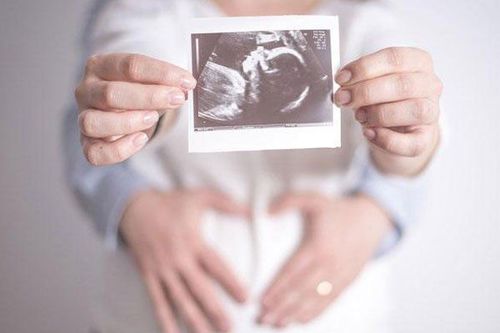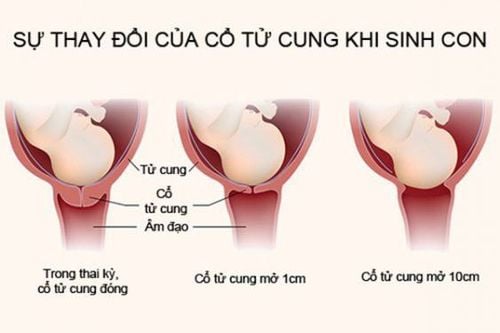This is an automatically translated article.
Professional consultation article by Doctor Department of Obstetrics and Gynecology, Vinmec Hai Phong International General Hospital.
The last three months of pregnancy is a very important time because the mother is preparing to welcome the baby in the womb to be born. During this period, pregnant women need to have regular antenatal check-ups to monitor the health of mother and baby. In addition, in the last three months, during regular antenatal check-ups, pregnant women are also instructed to recognize the signs of labor and promptly handle abnormalities that occur, preventing preterm labor.
1. Purpose of the third trimester antenatal checkup
Periodic antenatal check-ups are extremely necessary during pregnancy, especially in the last three months of pregnancy for the following reasons:
Pregnant women can understand the development of the fetus through prenatal visits including include: Maternal and fetal abnormalities; The development of the fetus and placenta Pregnant women are advised about nutrition or what to avoid during pregnancy to have a healthy pregnancy The accuracy of the test results is only for a certain period of time Therefore, pregnant women need to have regular antenatal check-ups according to the doctor's appointment to perform the necessary tests to monitor the health of mother and baby. The results of several studies show that mothers who adhere to routine antenatal care schedules have a 5-fold lower fetal mortality rate, and a higher proportion of babies born with a normal birth weight.
Trắc nghiệm: Bạn có hiểu đúng về dấu hiệu mang thai sớm?
Các dấu hiệu mang thai sớm không phải chỉ mỗi trễ kinh mà còn có rất nhiều dấu hiệu khác như xuất huyết âm đạo, ngực căng tức,… Điểm xem bạn biết được bao nhiêu dấu hiệu mang thai sớm thông qua bài trắc nghiệm này nhé!
2. Pregnant women in the last three months should have regular antenatal check-ups?
In the third trimester, pregnant women gain weight quickly and undergo many comprehensive changes in terms of psychophysiology, which can easily cause fatigue and exhaustion, but pregnant women still need to have regular antenatal care appointments to get a doctor's appointment. Monitor and take care of the health of both mother and baby.
In particular, pregnant women in the third trimester need to go to antenatal care more often and the interval between antenatal visits is often closer. Because in the third trimester, especially the last month before the due date is the time when the mother may have signs of labor giving birth to the baby. Therefore, the doctor needs to check the fetal heart more often to make sure that the fetus is always in a healthy condition, there is no fetal distress as well as antenatal check-ups to look for signs suggestive of labor.
In addition, when there are any abnormal signs such as bleeding, vaginal discharge, pain in the lower abdomen, abnormal fetal movement, suggesting fetal distress or signaling labor, pregnant women need to go to antenatal care. at the hospital immediately for timely detection and treatment of dangerous conditions for mother and fetus.

3. Schedule of antenatal check-ups in the last trimester
3.1. 28-32 weeks fetus: 1 time check-up Prenatal check-up: measure uterine height, measure waist circumference, listen to fetal heart fetus, give two injections one month apart, the second dose at least one month after the expected due date.
Tests:
Urine test: detect and treat diseases such as gestational hypertension, gestational diabetes, urinary-genital infections Fetal ultrasound: Identify fetal position and guide rotation fetal position Measure the length of the cervix to assess the risk of preterm birth Determine the position of the placenta and the maturity of the placenta Estimate the fetal weight through biological indicators of the fetus such as head circumference, length of the femur, abdominal circumference,... Color ultrasound: to assess the health status of the fetus through Doppler parameters of the umbilical artery, middle cerebral artery. 3.2. Fetal 32 - 36 weeks old: examination every 2 weeks/time. Tests:
Urine test: detect and treat diseases such as gestational hypertension, gestational diabetes, urinary-genital infections Fetal ultrasound: Identify fetal position and guide rotation Pregnancy Determining the position of the placenta and the maturity of the placenta Estimating fetal weight through biological indicators of the fetus such as head circumference, femur length, abdominal circumference, ... Non-Stress-Test (NST) depending on the case if indicated: to check the health of the fetus and check whether the baby is getting enough oxygen or not. 3.3. Fetal 36 - 39 weeks old: 1 week visit / time Prenatal checkup:
Measure the height of the uterus, measure the abdomen, listen to the fetal heart Internal examination, check the cervix and signs of impending birth. Laboratory tests:
Urinalysis: detecting and treating diseases such as gestational hypertension, gestational diabetes, urinary-genital infections Fetal ultrasound: Determining fetal position and guiding rotation Pregnancy Determining the position of the placenta and the maturity of the placenta Estimating fetal weight through biological indicators of the fetus such as head circumference, femur length, abdominal circumference, ... Non-Stress-Test (NST): to check the health of the fetus and check if the baby is getting enough oxygen. 3.4. Fetal after 39 weeks: examine every 3 days Purpose:
Find signs of labor Consider whether the pregnant woman can give birth naturally or not Consider continuing to monitor and wait for natural labor or intervention Termination of pregnancy for cases of pregnancy beyond the due date. The sequence of antenatal check-ups and necessary tests are similar to those from 36-39 weeks of age. Special examinations and tests during this period include:
Examination of the pelvis with an internal examination and pelvic X-ray. Color ultrasound at 40 weeks or more to check amniotic fluid and fetal health.
4. Things to note to see a doctor right away in the last three months of pregnancy

Reduced pregnancy: Pregnant women need to pay attention to counting the number of fetal movements each day in the morning, noon, afternoon, evening, or at least once a day if you are busy, each time counting for 30 minutes.
If the fetus has more than 4 movements in 30 minutes: the fetus is healthy. If the fetus moves less than 4 times: the mother needs to lie down and count the fetal movements for an hour, or from 2-4 hours. Since there is usually no fetal movement when the fetus sleeps, the average fetal sleep time varies from 20 minutes to 2 hours. If in 1 hour there are more than 4 fetal movements: the fetus is healthy. If in 4 hours there are more than 10 fetal movements, continue counting 3 times in a day as before: the fetus is still healthy. If within 4 hours there are less than 10 fetal movements or all fetal movements are weak: the mother needs to be hospitalized for further fetal monitoring by other methods. There are signs of labor: If you have the following signs, you need to go to the doctor immediately:
Feeling pain every time the abdomen is hard, the intensity of pain increases, the time between pain is shortened, there are from 3 attacks mound for 10 minutes or more. Pink vaginal discharge. Thin vaginal discharge (amniotic fluid).
The last 3 months of pregnancy directly affect the labor, so in addition to regular antenatal check-ups, pregnant women should also actively monitor the health of the baby through the pregnancy machine, this is also a very easy time to give birth prematurely. Therefore, when the body shows unusual symptoms, you should immediately go to a medical facility for examination.
To protect the health of the mother and baby comprehensively as well as help the mother feel more secure during labor, Vinmec provides a package Maternity service. With this package, the mother will have regular antenatal check-ups and routine tests to monitor her health. The fetus is monitored for fetal heart rate and uterine contractions with an obstetric monitor at 37-40 weeks of gestation to predict the exact time of delivery. During labor, the mother will be given pain-relieving techniques during and after birth such as: epidural anesthesia, pudendal nerve anesthesia (applied to normal delivery), postoperative pain treatment (applied to childbirth). surgery). In particular, Vinmec is deploying cold plasma services to help wounds heal quickly such as: cesarean section, perineal stitches, baby umbilical cord, and lactation to avoid swelling, redness, infection, and dryness. , flat, beautiful straight edge, little pain, no bruising, no convexity.

Please dial HOTLINE for more information or register for an appointment HERE. Download MyVinmec app to make appointments faster and to manage your bookings easily.













